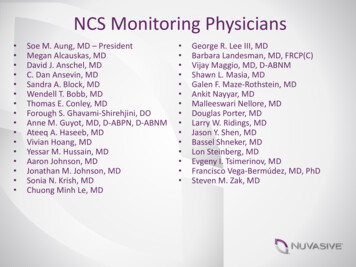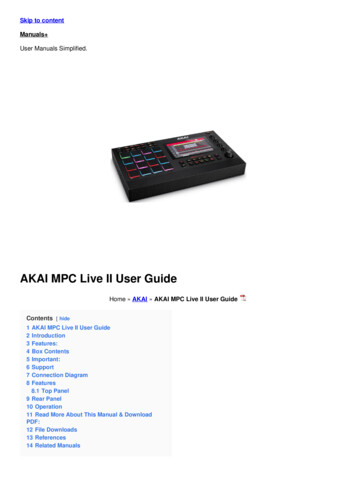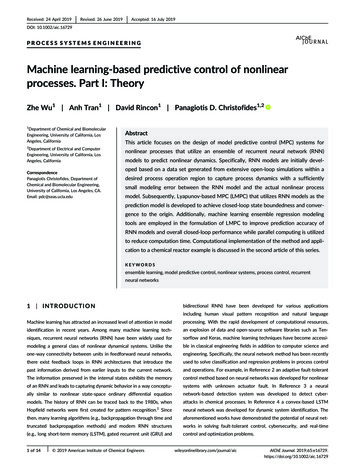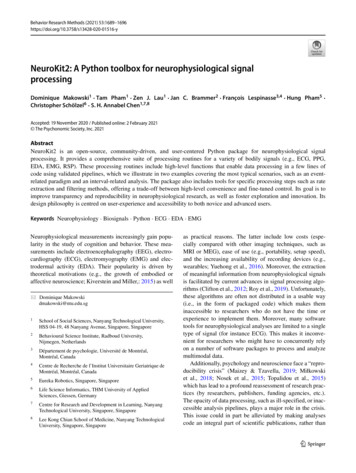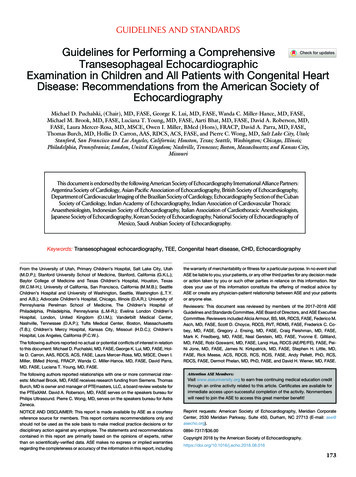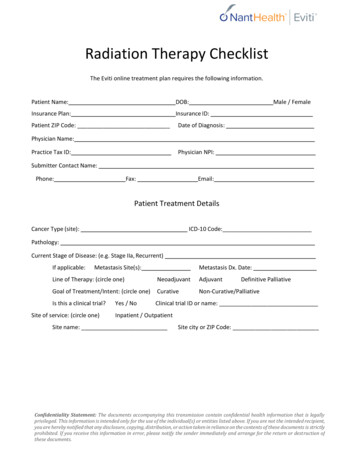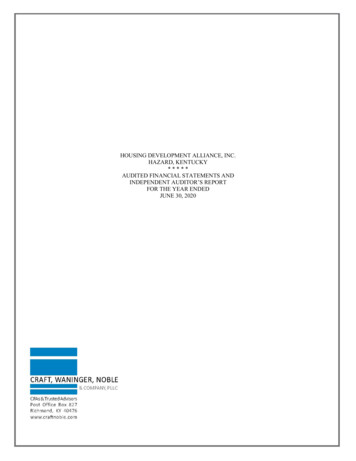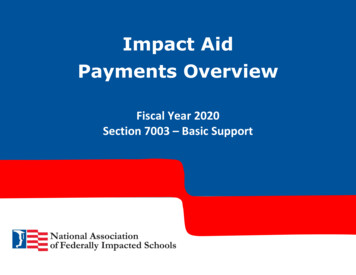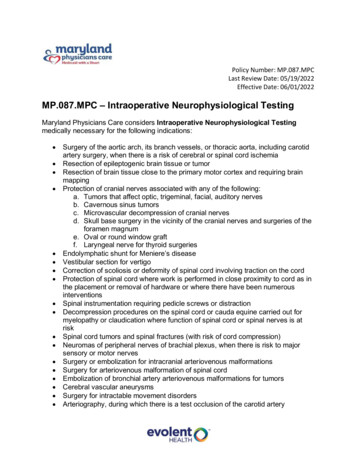
Transcription
Policy Number: MP.087.MPCLast Review Date: 05/19/2022Effective Date: 06/01/2022MP.087.MPC – Intraoperative Neurophysiological TestingMaryland Physicians Care considers Intraoperative Neurophysiological Testingmedically necessary for the following indications: Surgery of the aortic arch, its branch vessels, or thoracic aorta, including carotidartery surgery, when there is a risk of cerebral or spinal cord ischemiaResection of epileptogenic brain tissue or tumorResection of brain tissue close to the primary motor cortex and requiring brainmappingProtection of cranial nerves associated with any of the following:a. Tumors that affect optic, trigeminal, facial, auditory nervesb. Cavernous sinus tumorsc. Microvascular decompression of cranial nervesd. Skull base surgery in the vicinity of the cranial nerves and surgeries of theforamen magnume. Oval or round window graftf. Laryngeal nerve for thyroid surgeriesEndolymphatic shunt for Meniere’s diseaseVestibular section for vertigoCorrection of scoliosis or deformity of spinal cord involving traction on the cordProtection of spinal cord where work is performed in close proximity to cord as inthe placement or removal of hardware or where there have been numerousinterventionsSpinal instrumentation requiring pedicle screws or distractionDecompression procedures on the spinal cord or cauda equine carried out formyelopathy or claudication where function of spinal cord or spinal nerves is atriskSpinal cord tumors and spinal fractures (with risk of cord compression)Neuromas of peripheral nerves of brachial plexus, when there is risk to majorsensory or motor nervesSurgery or embolization for intracranial arteriovenous malformationsSurgery for arteriovenous malformation of spinal cordEmbolization of bronchial artery arteriovenous malformations for tumorsCerebral vascular aneurysmsSurgery for intractable movement disordersArteriography, during which there is a test occlusion of the carotid artery
MP.087.MPC – Intraoperative NeurophysiologicalTestingPolicy Number: MP.087.MPCLast Review Date: 05/19/2022Effective Date: 06/01/2022 Circulatory arrest with hypothermia (does not include surgeries performed undercirculatory bypass (e.g., coronary artery bypass grafting (CABG), ventricularaneurysms)Distal aortic procedures, where there is risk of ischemia to spinal cordLeg lengthening procedures, where there is traction on sciatic nerve or othernerve trunksBasal ganglia movement disordersSurgery as a result of traumatic injury to spinal cord/brainDeep brain stimulationLimitations The test must be requested by the operating surgeon and the monitoring must beperformed by a clinically trained neurophysiologist (MD/DO) other than theoperating surgeon, the surgical assistant, or the anesthesiologist rendering theanesthesia due to the high potential for morbidity.o Claims submission must include documentation for the time devoted todirect monitoring of the patient (time may be cumulative) A technologist must be present continuously in the operating suite recording andmonitoring a single case under the neurophysiologist’s supervision. Thistechnologist must have either the physical or electronic capacity for real-timecommunication with the supervising neurophysiologist The surgical team and the monitoring staff must always be able to be inimmediate contact with each other. Services must be performed in the inpatient setting only. Intraoperative monitoring is not medically necessary in situations where historicaldata and current practices reveal no potential risk to neural integrity duringsurgery. For coverage of remote monitoring (as mentioned above) the neurophysiologistmust have immediate physical or real-time communication with the operatingroom. He/she must have the ability to watch the tracings as they are obtained inreal-time in the operating room as well as the baseline electrophysiological testand the monitoring tracings from earlier in the case. The monitoring physician must have a plan in place to transfer care to anotherphysician, should any other situation arise during patient monitoring. Technical criteria – it is mandatory that at least 8 recording channels 16 if EEG ismonitored) be available for all Intraoperative neurophysiological monitoring(IONM). The equipment utilized must also provide for all of the monitoringmodalities that are needed such as auditory-evoked response,Page 2 of 11
MP.087.MPC – Intraoperative NeurophysiologicalTestingPolicy Number: MP.087.MPCLast Review Date: 05/19/2022Effective Date: 06/01/2022 electroencephalography/electrocorticography, electromyography/nerveconduction, and somatosensory-evoked response.IONM during thyroid surgery is considered reasonable and necessary if themonitoring service adheres to the essential standards described above, and thesurgical procedure involves the high-risk total removal of a complete lobe of thethyroid, removal of the entire gland, or involves re-entry (re-operation) to a priorsurgical field where scar tissue obscures the visual path of the recurrentlaryngeal nerve. The Contractor reserves the right to remove coverage formonitoring during thyroid surgery if the literature ultimately does not support thismonitoring.BackgroundThe Centers for Medicare and Medicaid Services (CMS) provides an overview onIntraoperative neurophysiological testing (IONT), stating that it may be used toidentify/prevent complications during surgery on the nervous system, its blood supply,or adjacent tissue. Monitoring can identify new neurologic impairment, identify orseparate nervous system structures (e.g., around or in a tumor) and can demonstratewhich tracts or nerves are still functional.Intraoperative neurophysiological testing may provide relative reassurance to thesurgeon that no identifiable complication has been detected up to a certain point,allowing the surgeon to proceed further and provide a more thorough or careful surgicalintervention than would have been provided in the absence of monitoring. Monitoring, ifused to assess sensory or motor pathways, should assess the appropriate sensory ormotor pathways. Incorrect pathway monitoring could miss detection of neuralcompromise and has been shown to have resulted in adverse outcomes.Codes:CPT Codes / HCPCS Codes / ICD-10 CodesCodeDescription95940Continuous intraoperative neurophysiology monitoring in theoperating room, one on one monitoring requiring personalattendance, each 15 minutes (List separately in addition to code forprimary procedure and in conjunction with the study performed)HCPCS codes covered if selection criteria are met (If Appropriate):Continuous intraoperative neurophysiology monitoring, from outsideG0453the operating room (remote or nearby), per patient, (attentionPage 3 of 11
MP.087.MPC – Intraoperative NeurophysiologicalTestingPolicy Number: MP.087.MPCLast Review Date: 05/19/2022Effective Date: 06/01/2022directed exclusively to one patient each 15 minutes (List in additionto primary procedure.ICD-10 codes covered if selection criteria are met:C41.2Malignant neoplasm of vertebral columnC70.0-C70.9Malignant neoplasm of meningesMalignant neoplasm of spinal cord, cranial nerves, and other partsof central nervous systemC72.0-C72.9C73Malignant neoplasm of thyroid glandC79.3-C79.49Secondary malignant neoplasm of brain and other parts of nervoussystemD21.0D32.0-D33.9Benign neoplasm of connective and other soft tissue of head, face,and neckBenign neoplasm for meninges, brain, and other parts of centralnervous systemD42.0-D42.9Neoplasm of uncertain behavior of meningesD43.0-D43.9Neoplasm of uncertain behavior of brain and central nervous systemNeoplasm of uncertain behavior of pituitary, craniopharyngeal, andpineal glands-Neoplasm of uncertain behavior of carotid body, aorticbody, and other paragangliaD44.3-D44.7D49.6Neoplasm of unspecified behavior of brainE07.89-E7.9Other specified or unspecified disorders of thyroidG06.1Intraspinal abscess and on-related (focal) (partial) symptomatic epilepsy andepileptic syndromes with simple/complex partial seizures, intractablewith or with status epilepticsG45.0G45.1Vertebro-basilar artery syndromeCarotid artery syndrome (hemispheric)G45.8Other transient cerebral ischemic attacks and related syndromesG45.9Transient cerebral ischemic attack, unspecifiedG46.0-G46.2Vascular syndromes of brain in cerebrovascular-middle, anterior,and posterior cerebral arteryG50.0Trigeminal neuralgiaPage 4 of 11
MP.087.MPC – Intraoperative NeurophysiologicalTestingPolicy Number: MP.087.MPCLast Review Date: 05/19/2022Effective Date: 06/01/2022G50.1G52.0-G52.9Atypical facial painDisorders of cranial nervesG53Cranial nerve disorders in diseases classified elsewhereG54.0Brachial plexus disordersG54.1Lumbosacral plexus disordersG54.2G54.3Cervical root disorders, not elsewhere classifiedThoracic root disorders, not elsewhere classifiedG54.4Lumbosacral root disorders, not elsewhere classifiedG80.4Ataxic cerebral palsyG80.8Other cerebral palsyG80.9Cerebral palsy, unspecifiedG93.5G95.0Compression of brainSyringomyelia and syringobulbiaH71.00-H71.93Cholesteatoma of middle earH74.40-H74.43Polyp of middle earH83.11-H83.19Labyrinthine fistulaI60.00-I60.9I61.0-I61.9Nontraumatic subarachnoid hemorrhageNontraumatic intracerebral hemorrhageI62.00-I62.9Nontraumatic subdural hemorrhageI63.00-I63.9Cerebral infarctionI65.01-I65.9Occlusion and stenosis of precerebral arteries, not resulting incerebral infarctionI66.01-I66.9Occlusion and stenosis of cerebral arteries, not resulting in cerebralinfractionI67.0I67.1Dissection of cerebral arteries, nonrupturedCerebral aneurysm, nonrupturedI67.5Moyamoya diseaseI67.841Reversible cerebrovascular vasoconstriction syndromeI67.848Other cerebrovascular vasospasm and vasoconstrictionI71.00Dissection of unspecified site of aortaPage 5 of 11
MP.087.MPC – Intraoperative NeurophysiologicalTestingPolicy Number: MP.087.MPCLast Review Date: 05/19/2022Effective Date: 06/01/2022I71.01I72.02Dissection of thoracic aortaDissection of abdominal aortaI71.03Dissection of thoracoabdominal aortaI71.1Thoracic aortic aneurysm, rupturedI71.2Thoracic aortic aneurysm, without ruptureI71.3I71.4Abdominal aortic aneurysm, rupturedAbdominal aortic aneurysm, without ruptureI71.5Thoracoabdominal aortic aneurysm, ruptureI71.6Thoracoabdominal aortic aneurysm, without ruptureI71.8Aortic aneurysm of unspecified site, rupturedI71.9Aortic aneurysm of unspecified site, without ruptureI77.71I77.74Dissection of carotid arteryDissection of vertebral arteryI77.79Dissection of other arteryI79.0Dissection of other arteryM40.00-M40.05Postural kyphosisM40.10-M40.15Other secondary kyphosisM40.202-M40.209Unspecified kyphosisM40.292-M40.299Other kyphosisM40.30-M40.37M40.40-M40.47Flatback syndromePostural lordosisM40.50-M40.57Lordosis, unspecifiedM41.00-M41.9ScoliosisM43.8X1-M43.8X9 Other specified deforming dorsopathiesM47.011-M47.029Anterior spinal and vertebral artery compression syndromesVertebral artery compression syndromesM47.10Other spondylosis with myelopathy, site unspecifiedM47.11Other spondylosis with myelopathy, occipito-atlanto-axial regionM47.12Other spondylosis with myelopathy, cervical regionPage 6 of 11
MP.087.MPC – Intraoperative NeurophysiologicalTestingPolicy Number: MP.087.MPCLast Review Date: 05/19/2022Effective Date: 06/01/2022M48.00-M48.08M50.00-M50.03Spinal stenosisCervical disc disorder with myelopathy-M51.04Intervertebral disc disorders with myelopathy, thoracic regionM51.05Intervertebral disc disorders with myelopathy, thoracolumbar regionM51.06Intervertebral disc disorders with myelopathy, lumbar regionM51.9Unspecified thoracic, thoracolumbar and lumbosacral intervertebraldisc disorderM96.2Postradiation kyphosisM96.3Postlaminectomy kyphosisM96.4M96.5Postsurgical lordosisPostradiation scoliosisP11.3Birth injury to facial nerveP11.5Birth injury to spine and spinal cordP14.0Erb’s paralysis due to birth injuryP14.1Klumpke’s paralysis due to birth injuryP14.3P14.8Other brachial plexus birth injuriesBirth injuries to other parts of peripheral nervous systemP14.9Birth injury to peripheral nervous system, unspecifiedQ05.0Cervical spinda bifida with hydrocephalusQ05.1Thoracic spina bifida with hydrocephalusQ05.2Q05.3Lumbar spina bifida with hydrocephalusSacral spina bifida with hydrocephalusQ05.4Unspecified spina bifida with hydrocephalusQ07.00Cervical, thoracic, lumbar, sacral, and unspecified spinal bifidawithout hydrocephalusArnold-Chiari syndrome without spina bifida or hydrocephalusQ07.01Arnold-Chiari syndrome with spina bifidaQ07.02Arnold-Chiari syndrome with hydrocephalusQ07.03Arnold-Chiari syndrome with spina bifida and hydrocephalusQ27.9Congenital malformation of peripheral vascular system, unspecifiedQ05.5-Q05.9Page 7 of 11
MP.087.MPC – Intraoperative NeurophysiologicalTestingPolicy Number: MP.087.MPCLast Review Date: 05/19/2022Effective Date: 06/01/2022Q28.2Q28.3Arteriovenous malformation of cerebral vesselsOther malformations of cerebral 6DS06.0X6SConcussion with loss of consciousness greater than 24 hours withreturn to pre-existing conscious levelConcussion with loss of consciousness without return to pre-existingconscious level (greater than 24 hours)S12.000AS12.9XXSFracture of cervical vertebra and other parts of neckS14.0XXAS14.9XXSInjury of nerves and spinal cord at neck levelS22.000AS22.089SFracture of the thoracic vertebraS24.0XXAS24.9XXSInjury of nerves and spinal cord at thorax levelS32.000AS32.059SOpen/closed fractures of lumbar spineS32.10XAS32.2XXSOpen/closed fractures of sacrum and coccyxS34.01XAS34.01XSS34.02XAS34.03XSConcussion and edema of lumbar spinal cordConcussion and edema of sacral spinal cordS34.101AS34.129SInjuries of lumbar spine and spinal cordS34.131AS34.139SInjuries of sacral spine and spinal cordS34.21XAS34.9XXSInjuries of nerve root of lumber, sacral, and unspecified nerves atabdomenS44.00XAS44.92XSInjuries of nerves at shoulder and upper arm levelS54.00XAS54.92XSInjuries of nerves at forearm levelPage 8 of 11
MP.087.MPC – Intraoperative NeurophysiologicalTestingPolicy Number: MP.087.MPCLast Review Date: 05/19/2022Effective Date: AS84.92XSS94.00XAS94.92XSInjuries of nerves at wrist and hand levelInjuries of sciatic verve and nerves at hip and thigh levelInjuries of nerves at lower leg levelInjuries of nerves at ankle and foot levelReferences1. American Academy of Neurology (AAN). Principles of Coding for IntraoperativeNeurophysiologic Monitoring and Testing- AAN Model Medical Policy. Approvedby the AAN Board of Directors, February 10, mmodelpolicy tr.pdf2. American Society of Electroneurodiagnostic Technologists (ASET). ASET – TheNeurodiagnostic Society. Position Statement: Unattended IntraoperativeNeurophysiologic Monitoring. Approved by the ASET Board of Trustees, March2012. ogicmonitoring.html3. Centers for Medicare and Medicaid Services (CMS). Local CoverageDetermination (LCD) No. L35003 – Intraoperative Neurophysiological Testing.(Contractor: Novitas Solutions). Revision Effective Date: atabase/details/lcddetails.aspx?LCDId 35003&ver 54&Date &DocID L35003&bc iAAAABAAAAAA&4. American Academy of Neurology and the American Clinical NeurophysiologySociety.Evidence-based Guideline Update: Intraoperative Spinal Monitoring withSomatosensory and Transcranial Electrical Motor Evoked Potentials. Lastreviewed: June 26, 2012. https://www.ncbi.nlm.nih.gov/pubmed/223517965. Kim SM, Kim SH, Seo DW, et al. Intraoperative neurophysiologic monitoring:basic principles and recent update. J Korean Med Sci. 2013 Sep;28(9):12611269. doi: 10.3346/jkms.2013.28.9.1261. Epub 2013 Aug 3097/6. Ney JP, Nuwer M, Patel Ad, et al. Evidence-based Guideline Update:Intraoperative Spinal Monitoring with Somatosensory and Transcranial ElectricalPage 9 of 11
MP.087.MPC – Intraoperative NeurophysiologicalTestingPolicy Number: MP.087.MPCLast Review Date: 05/19/2022Effective Date: 06/01/2022Motor Evoked Potentials: Report of the Therapeutics ad Technology AssessmentSubcommittee of the American Academy of Neurology (AAN) and the AmericanClinical Neurophysiology Society. - Letters to Editor and Author Responses, July16, 2012. Neurology. 2012 Jul; 79: full.pdf html7. Ney JP. Changes to CMS reimbursement rules for intraoperativeneurophysiological monitoring: implications for telemedicine. Telemed J E Health.2013 Oct;19(10):791-793. doi: 10.1089/tmj.2013.0004. Epub 2013 Aug 7403/8. Nuwer MR, Emerson RG, Galloway G, et al. Evidence-based Guideline Update:Intraoperative Spinal Monitoring with Somatosensory and Transcranial ElectricalMotor Evoked Potentials: Report of the Therapeutics ad TechnologyAssessment Subcomittee of the American Academy of Neurology (AAN) and theAmerican Clinical Neurophysilogy Society. Neurology. 2012 Feb; 78: full.pdf html9. Stanely AS, Cohen BA, Morledge DE, McAuliffe JJ, et al. Practice guidelines forthe supervising professional: intraoperative neurophysiological monitoring. J ClinMonit Comput. 2013 Sept;11. doi: nih.gov/24022172/10. Stecker MM. A review of intraoperative monitoring for spinal surgery. Surg NeruolInt. 2012 Jul ; 3(Suppl 3): /PMC3422092/Disclaimer:Maryland Physicians Care medical payment and prior authorization policies do notconstitute medical advice and are not intended to govern or otherwise influence thepractice of medicine. The policies constitute only the reimbursement and coverageguidelines of Maryland Physicians Care and its affiliated managed care entities.Coverage for services varies for individual members in accordance with the terms andconditions of applicable Certificates of Coverage, Summary Plan Descriptions, orcontracts with governing regulatory agencies.Maryland Physicians Care reserves the right to review and update the medical paymentand prior authorization guidelines in its sole discretion. Notice of such changes, ifnecessary, shall be provided in accordance with the terms and conditions of provideragreements and any applicable laws or regulations.These policies are the proprietary information of Maryland Physicians Care. Any sale,copying, or dissemination of said policies is prohibited.Page 10 of 11
MP.087.MPC – Intraoperative NeurophysiologicalTestingPolicy Number: MP.087.MPCLast Review Date: 05/19/2022Effective Date: 06/01/2022Page 11 of 11
ICD-10 codes covered if selection criteria are met: . G50.1 Atypical facial pain G52.0-G52.9 Disorders of cranial nerves . Fracture of cervical vertebra and other parts of neck : S14.0XXA-S14.9XXS Injury of nerves and spinal cord at neck level . S22.000A-S22.089S
